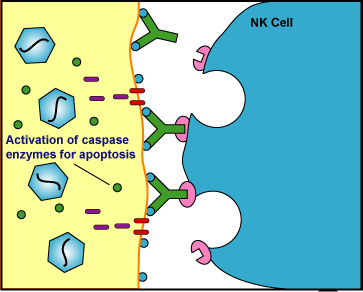
The Fab portion of the antibody binds to epitopes on the "foreign" cell. The NK cell then binds to the Fc portion of the antibody. The NK cell is then able to contact the cell and release pore-forming proteins called perforins and proteolytic enzymes called granzymes. Granzymes pass through the pores and activate the enzymes that lead to apoptosis of the infected cell by means of destruction of its structural cytoskeleton proteins and by chromosomal degradation. As a result, the cell breaks into fragments that are subsequently removed by phagocytes. Perforins can also sometimes result in cell lysis.
Last updated: August, 2019
Please send comments and inquiries to Dr.
Gary Kaiser